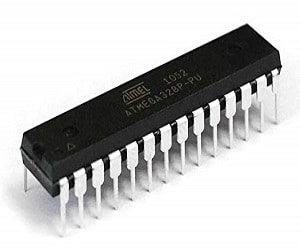
The ATmega328 is a microcontroller developed by Atmel (now part of Microchip Technology), and it is a member of the AVR family of microcontrollers. It is widely known for being used in the Arduino Uno board, which has made it one of the most popular microcontrollers in hobbyist and educational electronics projects
Architecture: 8-bit AVR RISC (Reduced Instruction Set Computing)
Clock Speed: Typically runs at 16 MHz (can be overclocked depending on your needs)
Flash Memory: 32 KB (with 0.5 KB used for the bootloader)
RAM: 2 KB of SRAM
EEPROM: 1 KB of Electrically Erasable Programmable Read-Only Memory (EEPROM) for non-volatile data storage
I/O Pins: 23 GPIO (General Purpose Input/Output) pins, of which 6 can be used as PWM outputs and 6 as analog inputs
Timers: 3 timers, used for time-based operations and generating PWM signals
Serial Communication: Supports UART (Universal Asynchronous Receiver/Transmitter) for serial communication, used in interfacing with other devices like computers or other microcontrollers
Interfacing: Supports I2C and SPI for communication with peripherals (like sensors, displays, etc.)
Power Supply: Operates on a voltage range of 1.8V to 5.5V, commonly run at 5V or 3.3V for certain applications
Common Applications:
Embedded Systems: Used in a variety of embedded systems for tasks like data processing, control, and automation.
Arduino Projects: One of the key microcontrollers used in the Arduino platform for DIY electronics, robotics, IoT (Internet of Things) devices, and more.
Prototyping: Ideal for rapid prototyping of electronics projects due to its ease of use and compatibility with the Arduino IDE (Integrated Development Environment).
Sensor Integration: Interfacing with various sensors (temperature, light, motion, etc.) and controlling actuators like motors, LEDs, etc.
Robotics: Widely used in small robotic systems where a simple and low-cost microcontroller is needed.